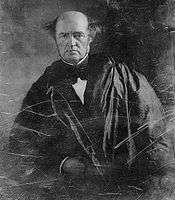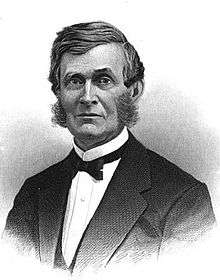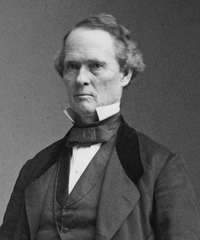1852 Democratic National Convention
|
1852 presidential election | |
|
Nominees Pierce and King | |
| Convention | |
|---|---|
| Date(s) | June 1–5, 1852 |
| City | Baltimore, Maryland |
| Venue | Maryland Institute for the Promotion of the Mechanic Arts [above Centre ("Marsh") Market] |
| Candidates | |
| Presidential nominee | Franklin Pierce of New Hampshire |
| Vice Presidential nominee | William R. King of Alabama |
The 1852 Democratic National Convention nominated the dark horse candidate Franklin Pierce for President on the 49th ballot, passing over better known candidates Lewis Cass of Michigan (the previous nominee in 1848), James Buchanan of Pennsylvania, and Stephen A. Douglas of Illinois. It was held at the Maryland Institute in the eastern downtown business district of Baltimore, Maryland, just two weeks before the opposing Whig Party met in the same hall for their nominating convention.
This convention was notable for the hostility between several groups within the party, divided over the "Compromise of 1850". The convention was called to order by Democratic National Committee chairman Benjamin F. Hallett. Romulus M. Saunders served as the temporary convention chairman and John W. Davis served as the permanent convention president.
Location
The Maryland Institute for the Promotion of the Mechanic Arts, then an academic institution founded 1825-1826 with a variety of curriculums including mechanical arts along with visual art and design, was located on the second floor of their recently constructed 1851 landmark structure with two clock towers at each end of the long structure set atop arched, stone and brick piers which covered the ancient "Centre Market", founded in the 1760s as the original main marketplace of old Baltimore Town. Located at Market Place (formerly Harrison Street) and South Frederick Street between East Baltimore Street on the north and Water Street (old colonial shoreline) to the south. It was also known as "Marsh Market" because of the old colonial marsh of Thomas Harrison then located along the western bank of the Jones Falls stream which flowed through downtown Baltimore to the Harbor), and east of "The Basin" (today's "Inner Harbor re-developed entertainment, commercial and hotel area) along the northern shore of the Patapsco River's Northwest Branch. 16th President Abraham Lincoln spoke at the Institute a decade later with his "Liberty Address" or "Baltimore Address" during the Sanitary Fair to raise money to benefit orphans and widows of Union Army soldiers and sailors, held by the United States Sanitary Commission in April 1864. Old Maryland Institute and the Centre Market buildings perished in the Great Baltimore Fire of February 1904. The Institute's buildings were rebuilt with three new parallel structures here for the marketplace and the second floors for the M.I.'s mechanical arts along with another "Main Building" at Mount Royal Avenue in northwestern city in 1906. They were razed in the 1980s for an entranceway into the new Baltimore "Metro" subway system, and one building (the old "Fish Market") was renovated as the "Port Discovery" children's museum, part of the new "Power Plant Live!" entertainment complex of the 1990s.
Presidential Candidates
-

Associate Justice Levi Woodbury of New Hampshire (Died Before Convention)
-

Former Congressmen and General William O. Butler of Kentucky
Withdrew During Balloting
The Convention


As Democrats convened in Baltimore in June 1852, four major candidates vied for the nomination- Lewis Cass of Michigan, the nominee in 1848, who had the backing of northerners in support of the Compromise of 1850; James Buchanan of Pennsylvania, popular in the South as well as in his home state; Stephen A. Douglas of Illinois, candidate of the expansionists and the railroad interests; and William L. Marcy of New York, whose strength was centered in his home state. Throughout the balloting, numerous favorite son candidates received a few votes.
Cass led on the first 19 ballots, with Buchanan second, and Douglas and Marcy exchanging third and fourth places. Buchanan took the lead on the 20th ballot and retained it on each of the next nine tallies. Douglas managed a narrow lead on the 30th and 31st ballots. Cass then recaptured first place through the 44th ballot. Marcy carried the next four ballots.
Franklin Pierce of New Hampshire, a former Congressman and Senator, did not get on the board until the 35th ballot, when the Virginia delegation brought him forward as a compromise choice, selecting Pierce as their dark horse by one vote over former New York Congressman and Brooklyn Mayor Henry C. Murphy.[1] After being nominated by the Virginia delegation, Pierce's support remained steady until the 46th ballot, when it began to increase at Cass's expense. Pierce's support was consolidated in subsequent voting, and he was nominated nearly unanimously on the 49th ballot.[2]
In a peace gesture to the Buchanan wing of the party, Pierce's supporters allowed Buchanan's allies to fill the second position, knowing that they would select Alabama Senator William R. King, to whom Pierce had no objections. King won the nomination on the second ballot. During the ensuing campaign, King's tuberculosis, which he believed he had contracted while living in Paris, denied him the active behind-the-scenes role that he might otherwise have played, although he worked hard to assure his region's voters with the statement that New Hampshire's Pierce was a "northern man with southern principles."
Ballots
Presidential Ballots
| Presidential Ballot | |||||||||||||||||||||||||
| Ballot | 1st | 2nd | 3rd | 4th | 5th | 6th | 7th | 8th | 9th | 10th | 11th | 12th | 13th | 14th | 15th | 16th | 17th | 18th | 19th | 20th | 21st | 22nd | 23rd | 24th | 25th |
|---|---|---|---|---|---|---|---|---|---|---|---|---|---|---|---|---|---|---|---|---|---|---|---|---|---|
| Franklin Pierce | 0 | 0 | 0 | 0 | 0 | 0 | 0 | 0 | 0 | 0 | 0 | 0 | 0 | 0 | 0 | 0 | 0 | 0 | 0 | 0 | 0 | 0 | 0 | 0 | 0 |
| Lewis Cass | 116 | 118 | 119 | 115 | 114 | 114 | 113 | 113 | 112 | 111 | 101 | 98 | 98 | 99 | 99 | 99 | 99 | 96 | 89 | 81 | 60 | 43 | 37 | 33 | 34 |
| James Buchanan | 93 | 95 | 94 | 89 | 88 | 88 | 88 | 88 | 87 | 86 | 87 | 88 | 88 | 87 | 87 | 87 | 87 | 85 | 85 | 92 | 102 | 104 | 104 | 103 | 101 |
| William L. Marcy | 27 | 27 | 26 | 25 | 26 | 26 | 26 | 26 | 27 | 27 | 27 | 27 | 26 | 26 | 26 | 26 | 26 | 25 | 26 | 26 | 26 | 26 | 27 | 26 | 26 |
| Stephen A. Douglas | 20 | 23 | 21 | 33 | 34 | 34 | 34 | 34 | 39 | 40 | 50 | 51 | 51 | 51 | 51 | 51 | 50 | 56 | 63 | 64 | 64 | 77 | 78 | 80 | 79 |
| Others | 40 | 33 | 36 | 34 | 34 | 34 | 35 | 35 | 31 | 32 | 31 | 32 | 33 | 33 | 33 | 33 | 34 | 34 | 33 | 33 | 44 | 46 | 50 | 54 | 56 |
| Presidential Ballot | |||||||||||||||||||||||||||||||||
| Ballot | 26th | 27th | 28th | 29th | 30th | 31st | 32nd | 33rd | 34th | 35th | 36th | 37th | 38th | 39th | 40th | 41st | 42nd | 43rd | 44th | 45th | 46th | 47th | 48th | 49th | |||||||||
|---|---|---|---|---|---|---|---|---|---|---|---|---|---|---|---|---|---|---|---|---|---|---|---|---|---|---|---|---|---|---|---|---|---|
| Franklin Pierce | 0 | 0 | 0 | 0 | 0 | 0 | 0 | 0 | 0 | 15 | 30 | 29 | 29 | 29 | 29 | 29 | 29 | 29 | 29 | 29 | 44 | 49 | 55 | 282 | |||||||||
| Lewis Cass | 33 | 32 | 28 | 27 | 33 | 65 | 93 | 123 | 130 | 131 | 122 | 120 | 107 | 106 | 107 | 107 | 101 | 101 | 101 | 96 | 78 | 75 | 72 | 2 | |||||||||
| James Buchanan | 101 | 98 | 96 | 98 | 91 | 83 | 74 | 72 | 49 | 39 | 28 | 28 | 28 | 28 | 27 | 27 | 27 | 27 | 27 | 27 | 28 | 28 | 28 | 0 | |||||||||
| William L. Marcy | 26 | 26 | 26 | 26 | 26 | 26 | 26 | 25 | 33 | 34 | 58 | 70 | 84 | 85 | 85 | 85 | 91 | 91 | 91 | 97 | 98 | 95 | 89 | 0 | |||||||||
| Stephen A. Douglas | 80 | 85 | 88 | 91 | 92 | 92 | 80 | 60 | 53 | 52 | 43 | 34 | 33 | 33 | 33 | 33 | 33 | 33 | 33 | 32 | 32 | 33 | 33 | 2 | |||||||||
| Others | 56 | 55 | 58 | 54 | 54 | 30 | 23 | 16 | 31 | 25 | 15 | 15 | 15 | 15 | 15 | 15 | 15 | 15 | 15 | 15 | 16 | 16 | 19 | 10 | |||||||||
Source: US President - D Convention. Our Campaigns. (August 24, 2009).
Vice Presidential Ballots
| Vice Presidential Ballot | ||
| Ballot | 1st | 2nd |
|---|---|---|
| William R. King | 125 | 277 |
| Solomon W. Downs | 30 | 0 |
| John B. Weller | 28 | 0 |
| David R. Atchison | 25 | 0 |
| Gideon J. Pillow | 25 | 0 |
| Robert Strange | 23 | 0 |
| William O. Butler | 13 | 0 |
| Thomas J. Rusk | 13 | 0 |
| Jefferson Davis | 2 | 11 |
| Howell Cobb | 2 | 0 |
| Abstaining | 2 | 0 |
Source: US Vice President - D Convention. Our Campaigns. (August 25, 2009).
See also
References
- ↑ Stiles, Henry Reed (1883). Memoir of Hon. Henry C. Murphy, LL.D., of Brooklyn, N.Y. The New York Genealogical and Biographical Record, Volumes 13-14. p. 14.
- ↑ William DeGregorio, The Complete Book of U.S. Presidents, Gramercy 1997
External links
- Proceedings of the Democratic national convention held at Baltimore, June 1-5, 1852
- Democratic Party Platform of 1852 at The American Presidency Project
| Preceded by 1848 |
Democratic National Conventions | Succeeded by 1856 |








.jpg)


